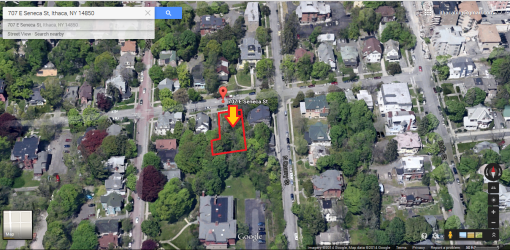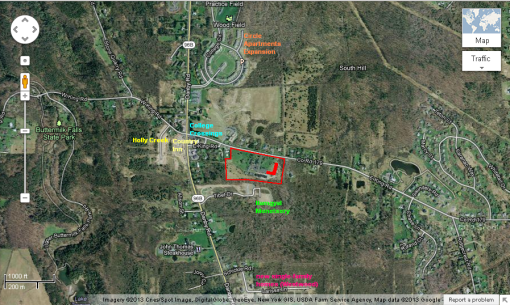1. The solar revolution is happening. Nothing makes that any clearer than putting up one of upstate’s largest solar arrays on land held as part of the Cayuga coal power point.
Just about every news agency in a fifty mile radius got the press release, but the Lansing Star has in-depth coverage. The $25 million project, to be built on 75 acres of the plant’s 434-acre site in Lansing, would create an 18 MW array that would be able to power 3,100 homes. 150 construction jobs would be created, although the permanent job growth is nearly nil. The site is well-suited because it is easy to hook-up to the existing grid, the zoning is appropriate, and Lansing is very keen on growing its tax base – overall, this seems like the right project at the right time. At a glance, this seems to skirt past the 2 MW rule from NYSDEC that limits each project’s size, as some arrays produce as much a 3.3 MW. However, there are nine arrays producing 18 MW, an average of 2 MW each for each array on the Cayuga plant’s property – so it technically meets regulations. It’s not clear if they have to pursue subdivision to make the panels fully legal.
Two potential debates are touched on in the Star article. For one, the project may pursue a solar tax PILOT, which would save a fair amount – instead of paying the property tax of about $770,625 (25 million on a tax rate of $30.825/1,000), they would pay something like $8,000/year/MW, just $144,000. The flipside is that local taxing authorities would not be enamored with such a deal. The second potential issue is that the Cayuga Operating Company was mum on whether they’ll close the coal plant, which is probably going to keep Town of Lansing officials up at night.
2. Ithaca College is in the hunt for a new president’s house. The house at 2 Fountain Place in the city’s East Hill neighborhood was deemed unsuitable because it’s difficult to maintain (it was built in 1892), it has an awkward interior layout, and there’s not enough space to host events (it’s 9100 SF on 1.06 acres). The property was designed by Ithaca’s famous 19th century architect William Henry Miller for lawyer George Russell Williams, and was purchased by the college in 1938. Although future options are still being considered, if this hits the market, we are talking a multi-million dollar sale, but lest anyone be concerned, given its historic designation the possibility of inappropriate alterations or demolition is remote. The most recent work was in 2013 for ADA accessibility at the rear porch, an ADA-suitable bathroom, and air conditioning. With 7 existing bedrooms and 5 bathrooms, it could make for a cool boutique hotel or B&B, if someone doesn’t want a personal residence with venerable grandeur.
While Ithaca College searches for a new residence (pursumably large, newer and on South Hill), incoming president Shirley Collado and her husband will live in a downtown apartment paid for by the college.
3. Hat tip to Chris Szabla for this one – the Al Huda Islamic Center planned for 112 Graham Road in Lansing village has been redesigned once again. It went from this in 2014:

to this in 2016:

Erm…with every due respect, this is a vinyl-sided modular with a poorly-photoshopped dormer and what appears to be a door in place of a garage. The first couple of designs embraced traditional Islamic architectural features, and the second was a great mix of traditional and contemporary design motifs. But this latest version honestly looks like, even if it was done for cost considerations, that every attempt was made to hide its use as a mosque and Islamic center. This image is so poorly done, I’m still not 100% sure if this is some kind of joke, but the floor plan matches up. Oof.
4. Not something one sees all the time – these are photos from last month’s deconstruction of Ithaca’s 107 South Albany Street in preparation for a new three-story, 11-unit apartment building. Developer Nick Stavropoulos hired Finger Lake Re-Use to do the deconstruction, which diverts about 70-90% of materials from the landfill by salvaging the structural components, processing and checking them to make sure they’re in good shape for re-use, and packaged and selling the materials at a low price to interested buyers – for instance, reclaimed lumber could go into bar counters, flooring, or any number of options looking for that well-used look. The cons to this approach are that more work and more time is involved vs. a traditional demolition, which means a greater cost. Also, though no fault of FLR, Historic Ithaca is not pleased (they get bonus shade for arguing in the same article the city should downzone to protect Patterson’s, an auto body shop built in 1983, and keep their “essential service” in downtown Ithaca). The pros are the environmental/sustainable aspect, the creation of “green-collar” jobs, and salvaged materials are tax deductible.
Construction on the new Daniel Hirtler-designed apartment building will begin this summer, with occupancy in about 12-13 months.
5. Skill-building for a good cause – The Second Wind Cottages, a housing complex in Newfield that houses formerly homeless men in 320 SF cottages, has connected with high school students and teachers to help assemble a new unit, cottage #13. Supervised students at a high school in suburban Rochester assembled a 320 SF unit in their school’s back lot as part of a class, then partially disassembled it and reassembled it in Newfield. The construction and transport process was borne out out over two days.
The non-profit project is led by local businessman Carmen Guidi, who hopes to do a second women’s housing plan further up Route 13 as the current 18-unit build-out wraps up.












































